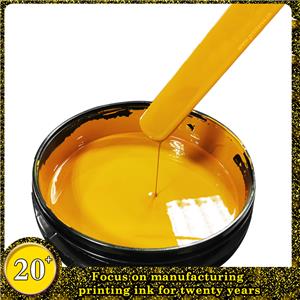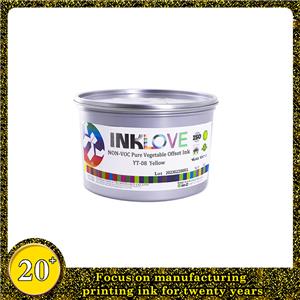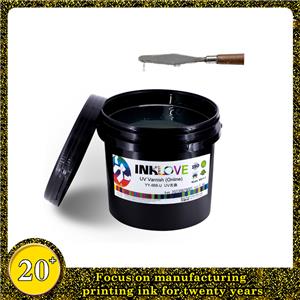What is Gravure Ink?
Gravure ink, also known as gravure liquid ink, is a stable colored colloidal dispersion system that can be coated on an appropriate substrate by an appropriate printing method to make it present text patterns and colors and provide information and attractiveness. The performance of gravure printing ink must first meet the needs of the gravure printing process, and secondly, the film layer of the ink transferred to the paper or other materials must be able to withstand the subsequent processes and various use conditions during the use of the printed product. These properties include flow properties, optical properties, and resistance properties. 1. Flow properties of the ink. The fluidity of ink is one of the main characteristics of printing ink, including viscosity, viscosity, viscoelasticity and so on.
①Ink viscosity. When a liquid is agitated, the speed of its flow is proportional to the applied force, that is, τ=MD (τ shear stress, M constant, D shear rate), where M is a constant, that is, the viscosity of the liquid, Different properties of liquids and different concentrations determine their different viscosities. If the viscosity of the binder of the ink is large, the viscosity of the ink is also large. The type and amount of solvent in the ink, the ratio and particle size of the pigment, and its dispersion will affect the viscosity of the ink. Gravure ink can be approximately regarded as a Newtonian fluid, and its yield value and thixotropy can be ignored, so its rheological curve is a straight line passing through the origin. In the printing process, the viscosity of the ink has a close relationship with the transfer of the ink. Generally, the higher the machine speed, the faster the ink separation speed. The lower the viscosity of the ink is required, otherwise the transfer effect is not ideal. In addition, the lower the surface strength of the paper. , the lower the viscosity of the ink is also required, otherwise it is easy to pull the paper wool. Therefore, in the gravure production process, the viscosity of the ink must be strictly controlled to ensure the printing effect.
② viscosity of ink. The so-called viscosity of the ink is the resistance of the ink layer when peeling off and transferring. The viscosity of the ink with high viscosity is also high, but there is no necessary connection between the two for different inks. The viscous ink is not only difficult to transfer to the surface of the paper, but also easy to pull out the paper wool on the surface of the paper, causing quality accidents.
③ Viscoelasticity of ink. The viscoelasticity of the ink is also the size of the cohesive force of the ink. The drawing of the ink is short, and the retraction is fast after breaking, so the viscoelasticity is strong, which is convenient for high-speed printing, the pattern is clear, and the flying ink is less. The viscoelasticity of the ink has a lot to do with the viscoelasticity of the binder.
2. Optical properties of ink.
① The color of the ink. The color of the ink refers to the color of the ink coated on the surface of the substrate, which is related to the nature of the light source, and generally refers to the color under an ideal light source. If the ink is completely opaque, when the light hits the surface of the ink, part of it is absorbed and the other part is reflected, and the combination of the reflected light is the color of the ink. If the ink is transparent, the light irradiates the surface of the ink, part of it is absorbed, part of it is reflected, and the other part is transmitted to the surface of the paper and then reflected, and comes out through the ink layer, and the color combined with the directly reflected part of the light is the color of the ink. color. There are many factors affecting the color of ink, such as thick ink layer, low brightness, dark color, whether the ink is dry or not, the reflection, transmission and absorption ratio of light are also different, and the color displayed is also different. The color of the paper itself is different, and the absorption of light by the whiteness also causes the color of the ink to change.
②The gloss of the ink. The gloss of the ink refers to the ability of the ink print to reflect light at a certain angle. The gloss of the ink has a great influence on the appearance of the printed product. The gloss is good and the color is bright, and the grade of the printed product appears to be high.
3. Resistance of ink. Whether the printed matter can maintain the original color during use is the performance of the quality of the printed matter, and it is also the performance of the good quality of the printing ink. Therefore, in order to ensure the quality of printed products, especially the quality of some special-purpose printed products, the corresponding resistance performance of the ink must be improved. Under the influence of sunlight, temperature and humidity, and pH of most pigments, its molecular structure or crystal structure is easy to change, which leads to color changes. Generally, the resistance of organic pigments is worse than that of inorganic pigments. Therefore, gravure inks must be used in gravure printing inks. Appropriately adjust the resistance material to improve its resistance ability.
Print Area is professional in printing industry 20+ years.
Security Paper:Watermark Paper,UV Fiber Paper,Thread Paper
Security Ink:OVI,UV Invisible Ink,Magnetic Ink,Water Sensitive Ink,Watermark Ink,Glow in Dark Ink
Offset Ink:Soy Bean Offset Ink,UV Offset Ink
Printing Materials:PS Plate,Rubber Blanket,Underpacking Foil,Underpacking Paper.
Machine:Die Cutting Machine,Offset Machine,UV Flexo Machine,UV Coated Machine ect.
Please don’t wait and contact with
Caroline:+8618026391301(wechat & whatsapp avaliable.)
Email:fluorescentink@yyink.com
Web:www.printarea.cn





